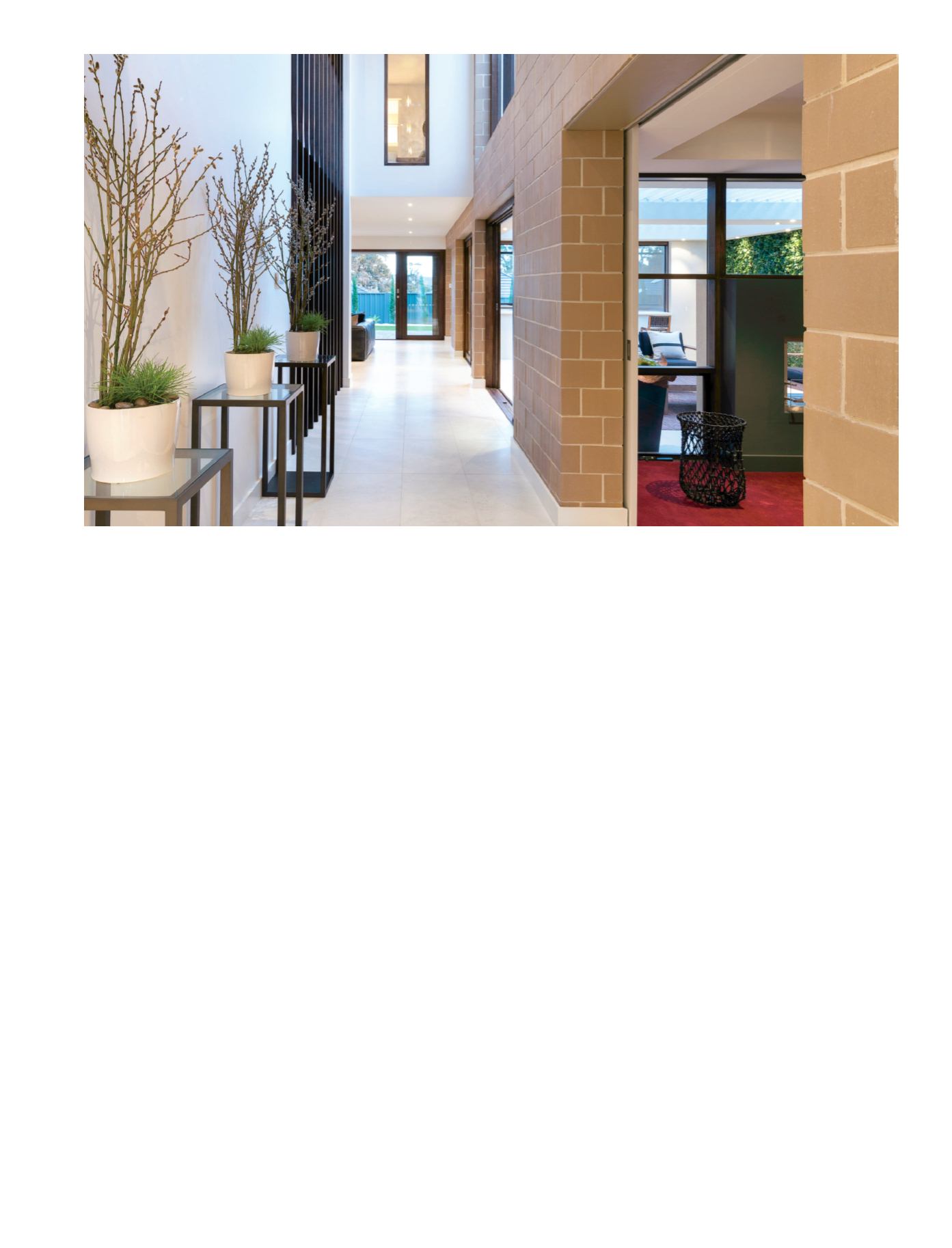

design
mag |
129
Here the design approach is more allied to
blurring the distinction between inside and
out and creating a low maintenance holiday
home in a challenging, corrosive
environment. Unlike many building materials
that require constant refinishing in a
beachside locations, concrete masonry and
clay bricks are self-finished and most are
rated as resistant to salt attack.
The Wall was the appropriate name for Scott
Salisbury’s distinctive Adelaide home that
features a two-storey central spine wall
constructed in large-format clay blocks.The
massive wall effectively cleaves the floor plan,
punctuated here and there with large
openings and popping up as a backdrop in
every room including the upper-level
bedrooms and ensuites.
The tan brick colour and light mortar colour
are picked up in decor and furnishings and
complementary interior finishes. Once again,
the internal placement of this large mass has
the potential to enhance the building’s
thermal performance.
The Aperture House by Cox Rayner Architects
in collaboration with Twofold Studio is a
celebration of internal face brickwork in all its
forms.The winner of this year’s Horbury Hunt
Residential Award (part of the Think Bricks
Awards), the design fully exploits the modular
diversity inherent in brickwork, with hit-and-
miss (perforated) walling, open perpends,
and brick flooring in an extension that adds
utility and character while linking the
renovated inner-Brisbane worker’s cottage to
a revitalised back garden.
There’s full coverage of this exciting project on
page 26 of this issue of
design
mag, but the
Think Brick Awards jury comments described it
best as “A series of artful and finely crafted brick
elements create spaces, edges and openings
that are inherently adaptable and
atmospheric.”
A further approach is shown in the Pullenvale
House by Arkhefield (also covered in more detail
on page 92 of this issue of
design
mag) which
features a long (40 metre) wall that defines the
southern boundary and acts as an internal
circulation corridor facilitating access to the
linear room programming spread along the
north.
Architect Karen Ognibene saw brickwork as
“just a way of bringing the landscape into the
house” while enhancing texture without adding
to the material palette.
Finally, Judd Lysenko Marshall Architects took
that modularity to the max in the Pane House,
creating vibrant splashes of colour that run
through the interior and exterior (see inside
front cover).
In all there are seven different face brick colours
in the Pane House, ranging from a
conventional, inexpensive extruded brick in a
tan colour to pressed bricks from Bowral Bricks in
black and off-white, three high gloss colours
from Austral Bricks Burlesque collection, and an
Austral Bricks Elements semi-glazed brick.
The takeaway from these examples if that there
are no hard-and-fast rules when using clay
bricks or concrete masonry for internal walling:
• It can be a small feature wall or a whole
house, or anywhere in between.
• Choose a single, solid colour. Or don’t.
• Large format masonry units (clay or
concrete) look great. So do standard brick
sizes.As does mixing the two sizes, with
alternating bands.
• Some designs (and designers) favour flush
mortar joints.Another may rake back some
or all joints to create shadow lines. (The
Pullenvale House rakes the horizontal or bed
joints but not the vertical or perpend joints
to subtly accent the brickwork’s
horizontality.)
• Colour match the mortar to the unit?
If you wish, or you can contrast.Again it’s
your call.
Whatever your choice, placing clay or
concrete masonry on the inside has the
potential to add to a building’s thermal
performance.
The design and detailing of internal masonry
walling can be a little demanding but some
would say less so than a true minimalist
design.As Kevin McCloud has observed on
many occasions, a high-spec minimalist
interior demands precision detailing because
there is nowhere to hide.
Defining what is character in a home is
elusive to the point of being both impossible
and irrelevant.What can be said is that
character is not a discreetly placed cushion
or vase. It’s that elusive quality that makes a
house a home.
Project:
The Wall
Location:
Craigburn Farm SA
Designer/builder:
Scott Salisbury Homes
Bricklayer:
BVDK Bricklaying
Featured product:
Austral Brick
Colossus
™
clay blocks in Aniseed
Photography:
Mark Zed















